
This is the second report on the results of the G,S&C survey* conducted last month (Click here for Part 1 – Christian Connectedness).
This reports cover several aspects of people’s current experience during the pandemic. Here we provide a summary of the results related to Mental Resilience, which included respondents’ perceptions of concern about:
- feelings of loneliness and isolation.
- feelings of anxiety.
- mental wellbeing.
- home and family relationships.
- financial security.
The results for the whole group are summarised in the graph below. The least concern was about financial impact of the pandemic. But at least a third of participants were concerned about:
- loneliness and isolation
- anxiety
- mental wellbeing

The area of the bars in blue indicates the proportion of people who did not share a concern in each domain. The area in green indicates the proportion of people for whom this domain was a concern.
A deeper dive into the demographics provides a richer picture. For this analysis, we looked at the respondents’ role in the church, living context and location. The results are summarised in the following sections.
Impact of the Pandemic on Feelings of Loneliness and Isolation
Respondents’ feelings of loneliness and isolation were analysed in relation to their role in the church, living context and location, summarised in the graphs that follow.
An increased feeling of loneliness and isolation due to the pandemic was more prevalent in:
- employed pastoral staff.
- those who live alone.
- those in the ACT and in LGAs of concern.
The reported feelings of loneliness and isolation was significantly less among elders than the other groups. Living context had no impact of perceptions of loneliness and isolation.
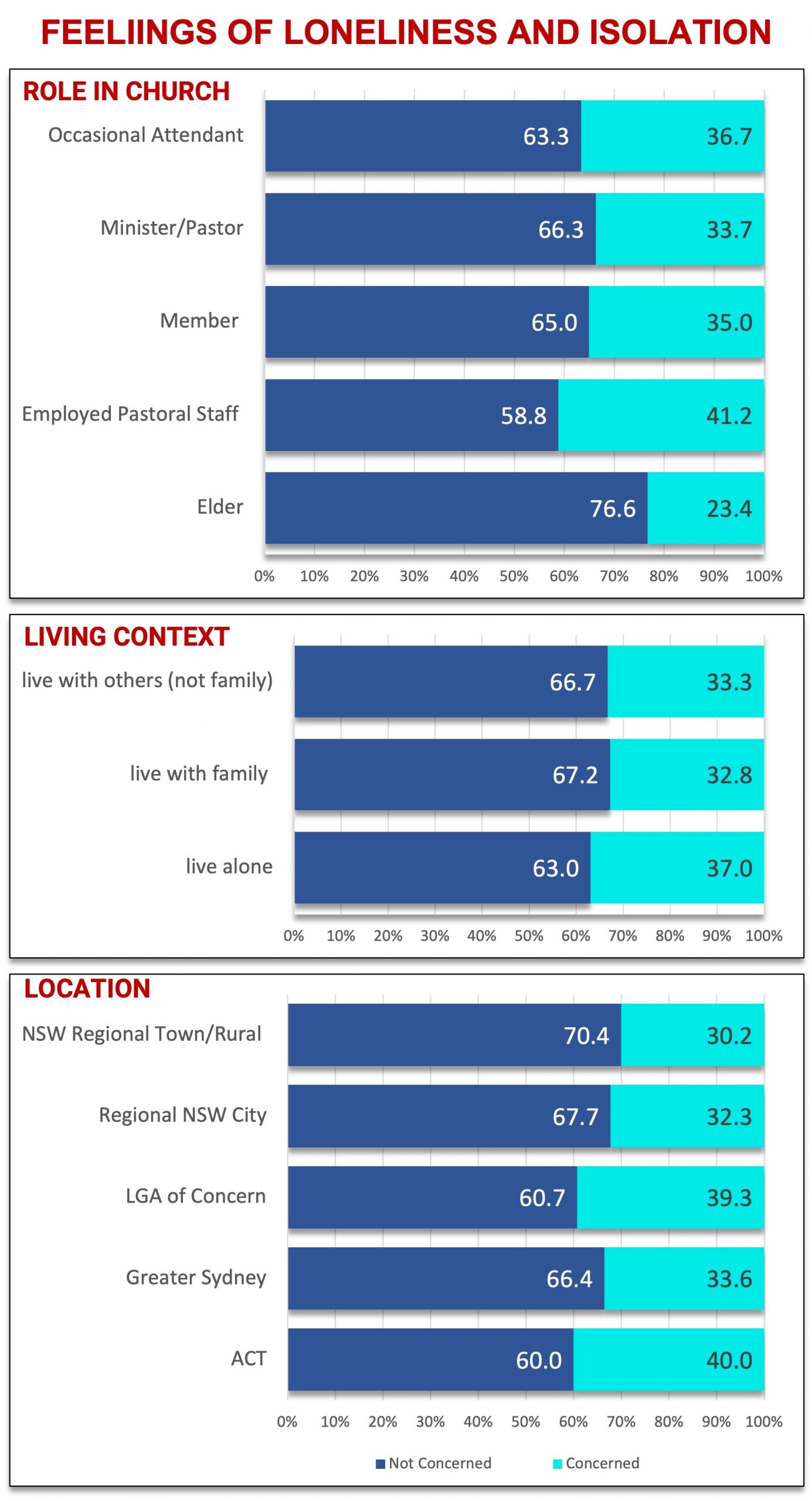
Loneliness and Isolation: These graphs summarise the respondents’ feelings of loneliness and isolation during the pandemic based on their role in the church, their living context and their location. The area of the bars in dark blue indicates the proportion of people who did not report feeling isolated and lonely. The area in light blue indicates the proportion of people for whom loneliness and isolation were a concern. Note, these bars represent the relative percentage in each subgroup.
Impact of the Pandemic on Feelings of Anxiety
Respondent’s feelings of anxiety were also analysed in relation to their role in the church, living context, and location. This is summarised in the graphs that follow.
An increased feeling of anxiety due to the pandemic was more prevalent in:
- employed pastoral staff, and in both church members and occasional attendees.
- those who live with others.
- those in the ACT.
The reported feelings of anxiety were significantly less among elders and ministers than the other groups and significantly greater for those in the ACT. Living context had no significant impact of these feelings.
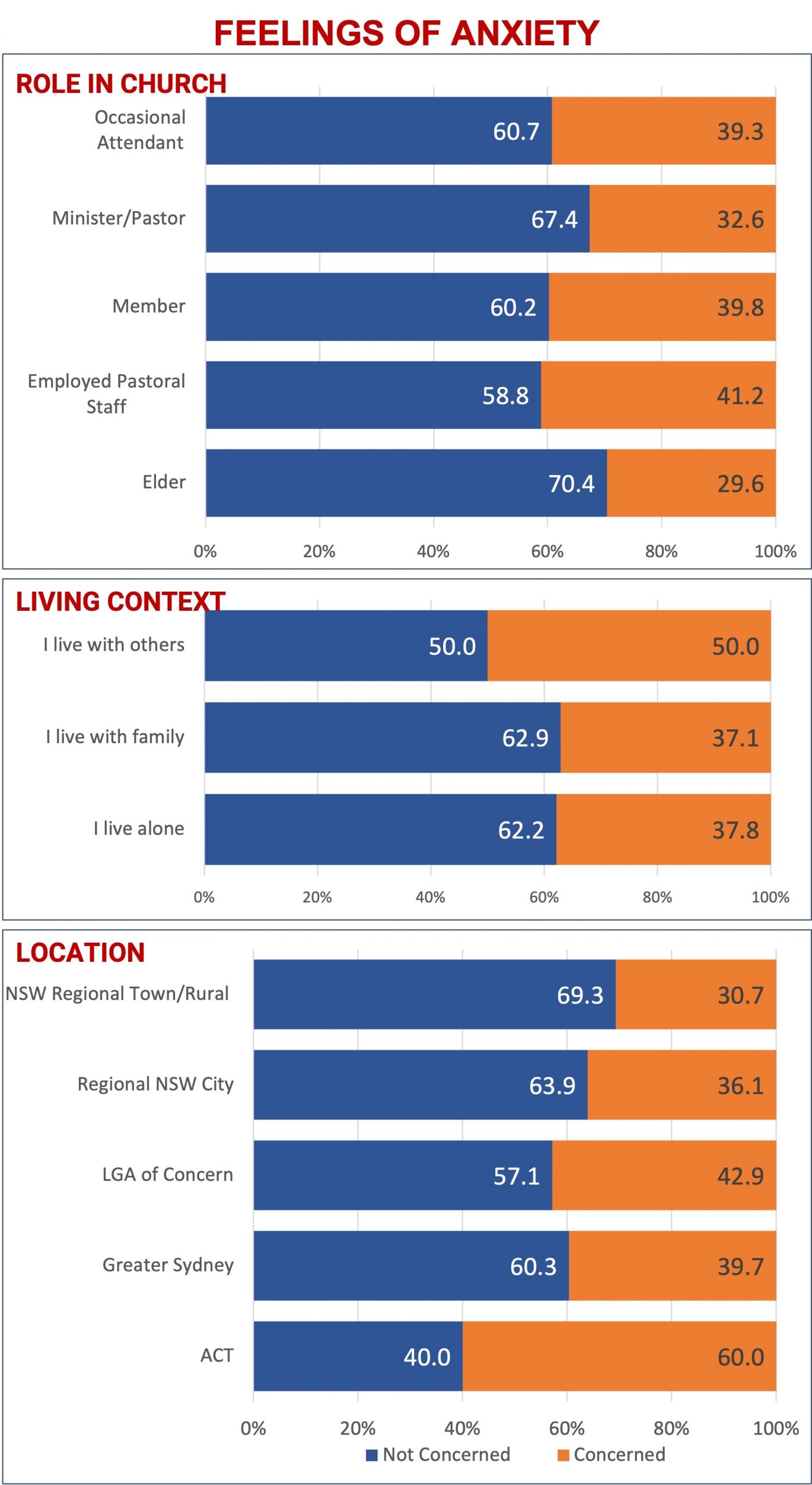
Anxiety. These graphs summarise the respondents’ feelings of anxiety during the pandemic based on their role in the church, their living context and their location. The area of the bars in dark blue indicates the proportion of people who did not feel more anxious. The area in orange indicates the proportion of people for whom anxiety was a concern. Note, these bars represent the relative percentage in each subgroup.
Perceived Impact of Pandemic on Personal Wellbeing
An analysis of the perceptions of impact on wellbeing related to respondents’ location, living context and role in the church was conducted and is summarised in the graphs that follow.
Concern about the impact of the pandemic on wellbeing was more prevalent in those who were:
- occasional attendees and church members.
- living with others, who were not family.
- living in LGAs of concern, ACT and Greater Sydney.
Those who had least concern about impact on wellbeing were employed staff, elders and ministers.
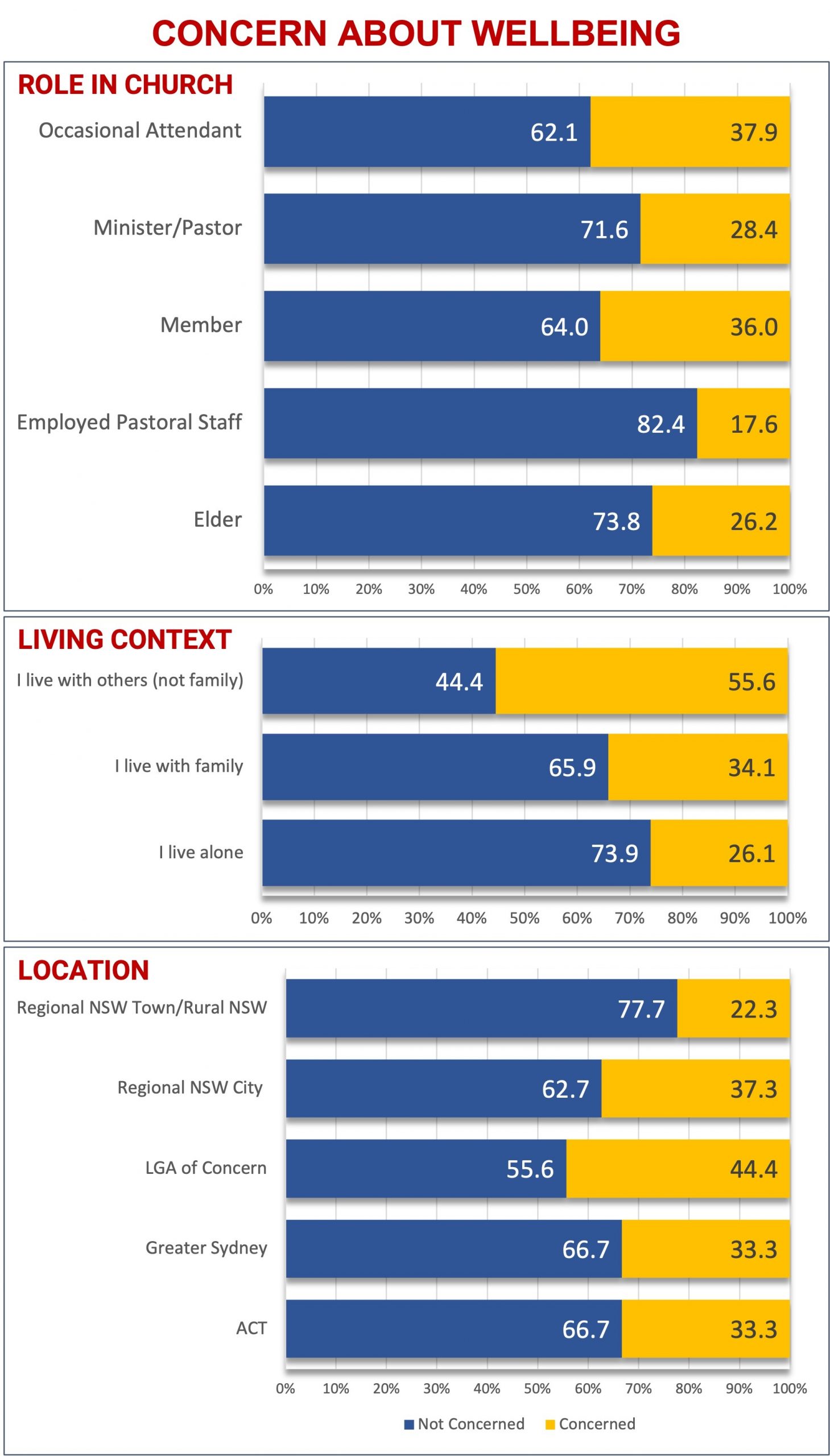
Wellbeing: These graphs summarise the respondents’ perceptions of the impact of the pandemic on wellbeing based on their role in the church, their living context and their location. The area of the bars in blue indicates the proportion of people who did not perceive a negative impact on their wellbeing due to the pandemic. The area in yellow indicates the proportion of people for whom wellbeing was a concern. Note, these bars represent the relative percentage in each subgroup.
Perceived Impact on Home and Family Relations
An analysis of the perceived concern about home and family relations related to respondents’ location, living context, and role in the church was conducted and is summarised in the graphs that follow.
Concern about the home and family relations was more prevalent in those who were:
- occasional attendees.
- living with others who were not family.
- in LGAs of concern.
Those who had the least concern about impact on home and family relations were employed staff.
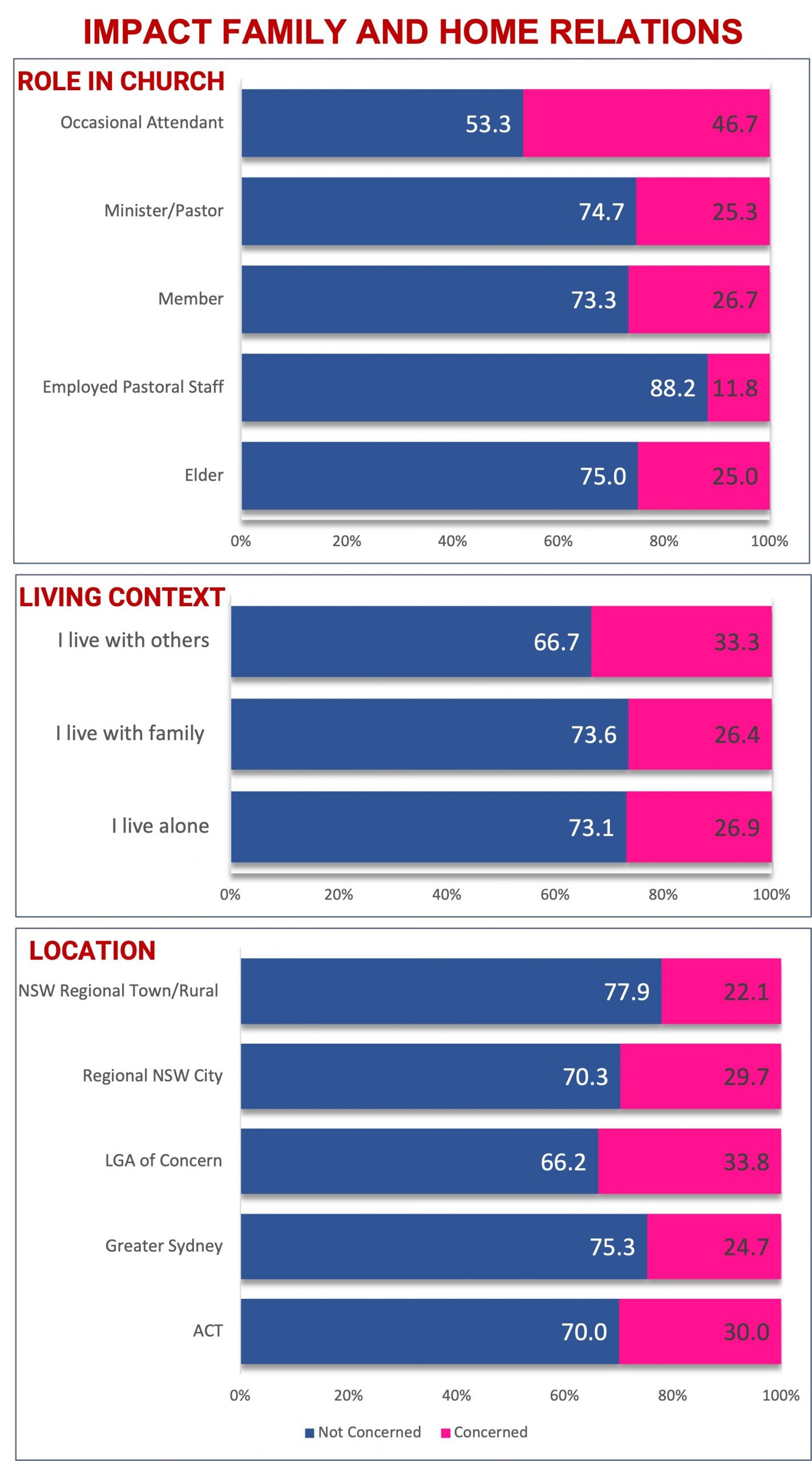
Home and Family Relations: These graphs summarise the respondents’ perceptions of the impact of the pandemic on home and family relations based on their role in the church, their living context and their location. The area of the bars in blue indicates the proportion of people who did not perceive an impact on their close relations due to the pandemic. The area in pink indicates the proportion of people for whom wellbeing was a concern. Note, these bars represent the relative percentage in each subgroup.
Perceived Impact on Finances
An analysis of the perceived concern about finances related to respondents’ location, living context and role in the church was conducted and is summarised in the graphs that follow. Of note, there was least concern about finances among respondents.
Those who were concerned about finances were more likely to live in LGAs of concern and the ACT. They were least likely to be ministers and elders.
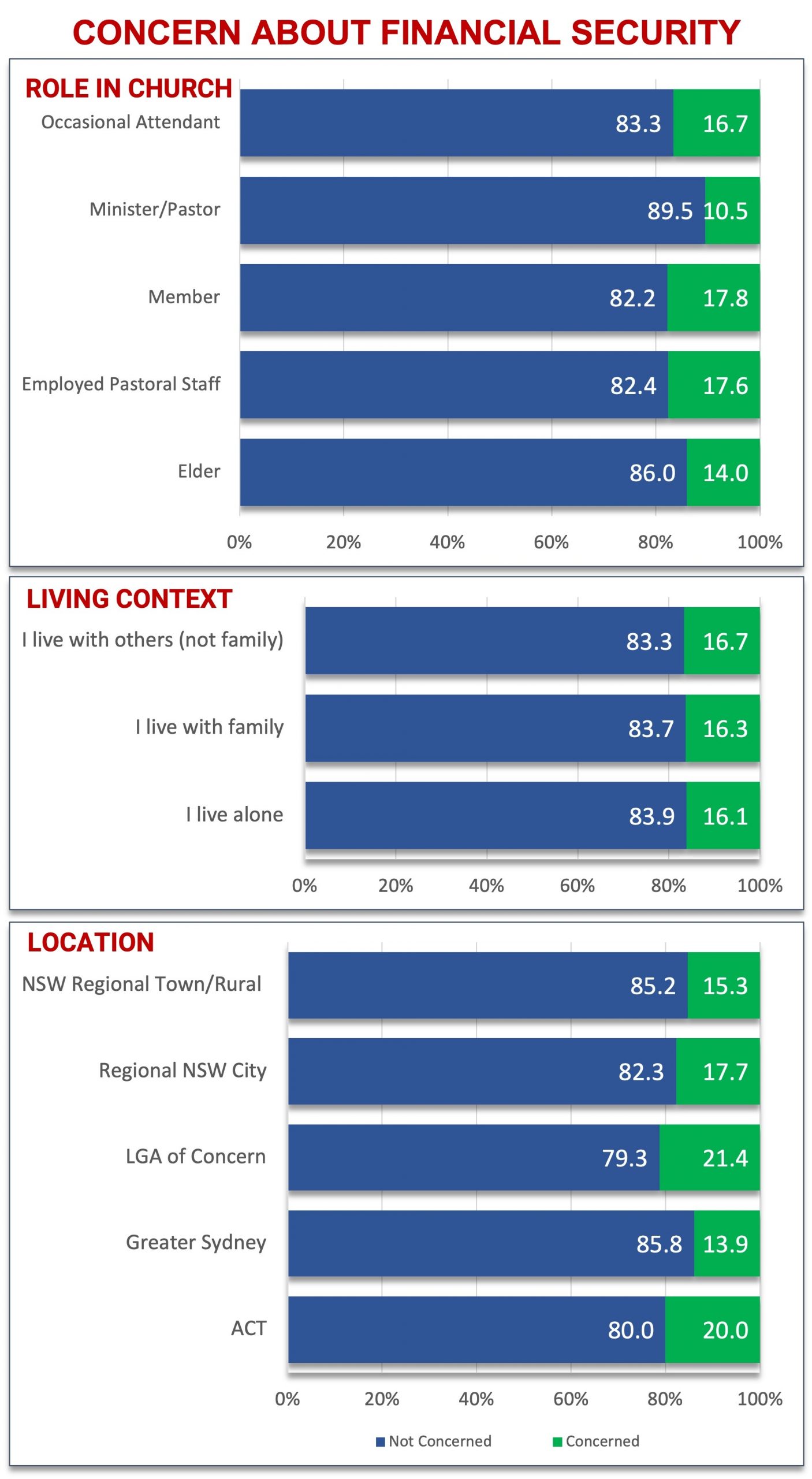
Finances: These graphs summarise the respondents’ perceptions of the impact of the pandemic on their financial security based on their role in the church, their living context and their location. The area of the bars in blue indicates the proportion of people who did not perceive an impact on their finances due to the pandemic. The area in green indicates the proportion of people for whom finances was a concern. Note, these bars represent the relative percentage in each subgroup.
Top Photo: Monstera from Pexels
You are still able to complete the survey using this link. We will update the data as appropriate.
*Limitation of the Survey
Surveys are a reliable and efficient means of measuring sentiment, challenging/validating assumptions, obtaining opinion and monitoring change over time. They are frequently used to inform local debates and decisions, and to measure impact and support of policies and initiatives. They can also provide evidence to determine appropriate initiatives.
However, as with all methods of data collection, surveys have limitations. We have summarised a few key limitations here but are also aware that there may be others.
Firstly, while we can quantify the perceptions of respondents, interpretation of the results is both complex and challenging without the opportunity to follow up with discussion. We need to be reminded that this data is a measure of perceptions of people only and are relevant to a particular time.
Secondly, the survey was distributed via email and social media. We accept that this distribution methods limit access to the survey.
Thirdly, we accept that the questions may be phrased in ways that were challenging for some people.
Fourthly, we are mindful not to introduce our biases in reporting the data to you. Hence, we provide in these reports a summary of the data without interpretations of what it could possibly mean. We will discuss our interpretations in upcoming blogs, papers and seminars.
